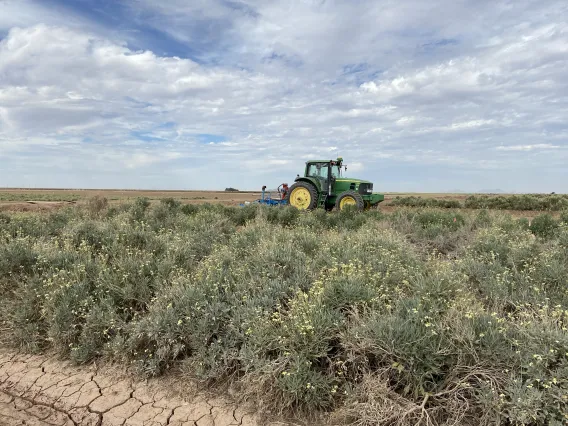The ambition of agriculture to do more with less presents some real challenges to growers, but help is on the way. Plant biostimulants are any substances or microorganisms applied to plants with the aim of enhancing the efficiency of nutrient use, increasing abiotic stress tolerance and/or improving crop quality. Unfortunately, increasing reliance on agrochemicals has caused damage to groundwater resources, soil fertility, soil biodiversity, and the environment. But biostimulants offer a means to create a better balance in our farming practices.
Many growers are familiar with the benefits of applying, for example, seaweed extracts to their crops or the key substances of one plant being shared with another to generate improved results. This direction, plant essences of one plant being used on another, offers a way of doing more with less.
Parthenium argentatum is a perennial woody shrub in the family Asteraceae that is native to the rangeland areas of the Chihuahuan Desert including the southwestern United States and northern Mexico. Parthenium argentatum is commonly harvested as an excellent source of high-end natural rubber.
Andaman Ag sells a product called SilverStim that’s made from the Parthenium argentatum. By tapping into the stress-adaptive traits of Parthenium argentatum, we unlock a natural solution to enhance the resilience of other crops. The very characteristics that allow it to endure desert extremes can be harnessed to improve stress tolerance, yield, and quality in plants facing their own challenges of drought, heat, or poor soil conditions.
The results that we’re seeing from the application of guayule are also extreme. In processed tomato trials with Colusa County Farm Supply, the paid tons per acre were 75.1 or 90.1% perfect fruit. The highest grower standard comparison is 62.5 tons or 80.34% perfect fruit.
Two years of trials in the Santa Maria area involving eight growers generated a BRIX range for treated strawberries of 12 to 14; untreated was 10 to 11. Yield increases were between 37% and 78%. In addition, most growers didn’t use starter fertilizer, and most were able to reduce their NPK applications. We also witnessed more flowering and fruiting throughout the season.
The key benefits of SilverStim are:
- Enhanced yield and quality
- Compatibility with existing crop programs
- Improved stress tolerance
- Cost-effective applications at low use rates
- Improved ROI
SilverStim can be applied to a variety of crops, perennials, and row crops. We also know that it does a great job of helping other applications work better and be more effective, including crop protection products and the uptake of nutrients. Chemical or non-chemical fungicides, insecticides, and herbicides performances are enhanced with the addition of a very small amount of product.
Please get in touch with me should you have any questions.





